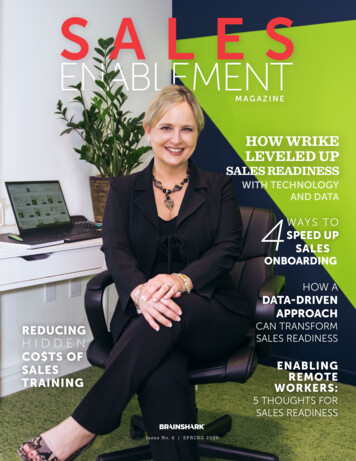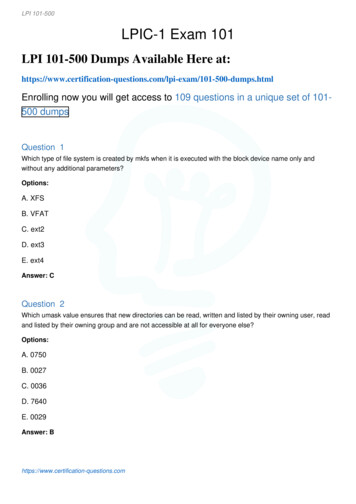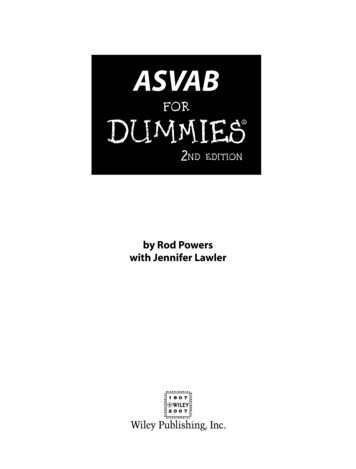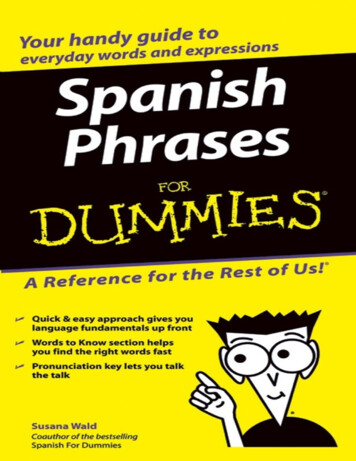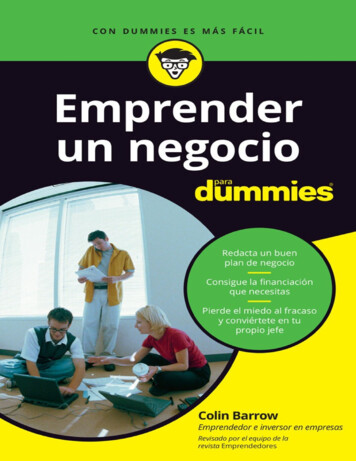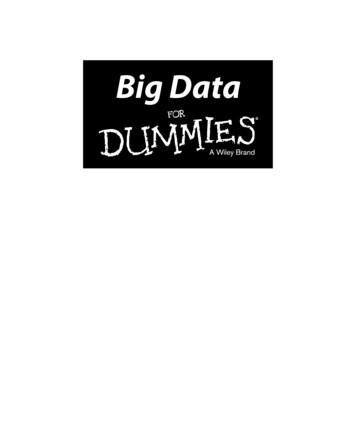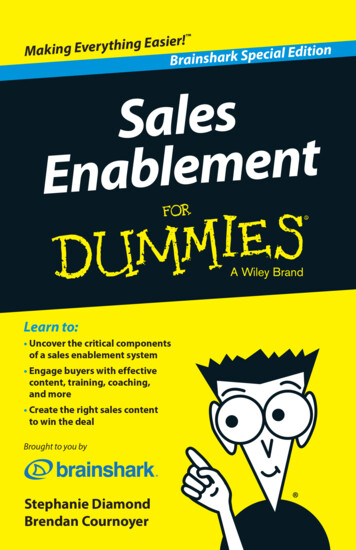
Transcription
SalesEnablement Brainshark Special Editionby Stephanie DiamondThese materials are 2015 John Wiley & Sons, Inc. Any dissemination, distribution, or unauthorized use is strictly prohibited.
Sales Enablement For Dummies , Brainshark Special EditionPublished byJohn Wiley & Sons, Inc.111 River St.Hoboken, NJ 07030‐5774www.wiley.comCopyright 2015 by John Wiley & Sons, Inc., Hoboken, New JerseyNo part of this publication may be reproduced, stored in a retrieval system or transmitted in anyform or by any means, electronic, mechanical, photocopying, recording, scanning or otherwise,except as permitted under Sections 107 or 108 of the 1976 United States Copyright Act, without theprior written permission of the Publisher. Requests to the Publisher for permission should beaddressed to the Permissions Department, John Wiley & Sons, Inc., 111 River Street, Hoboken,NJ 07030, (201) 748‐6011, fax (201) 748‐6008, or online at http://www.wiley.com/go/permissions.Trademarks: Wiley, For Dummies, the Dummies Man logo, The Dummies Way, Dummies.com,Making Everything Easier, and related trade dress are trademarks or registered trademarks of JohnWiley & Sons, Inc. and/or its affiliates in the United States and other countries, and may not be usedwithout written permission. All other trademarks are the property of their respective owners. JohnWiley & Sons, Inc., is not associated with any product or vendor mentioned in this book.LIMIT OF LIABILITY/DISCLAIMER OF WARRANTY: THE PUBLISHER AND THE AUTHOR MAKENO REPRESENTATIONS OR WARRANTIES WITH RESPECT TO THE ACCURACY ORCOMPLETENESS OF THE CONTENTS OF THIS WORK AND SPECIFICALLY DISCLAIM ALLWARRANTIES, INCLUDING WITHOUT LIMITATION WARRANTIES OF FITNESS FOR APARTICULAR PURPOSE. NO WARRANTY MAY BE CREATED OR EXTENDED BY SALES ORPROMOTIONAL MATERIALS. THE ADVICE AND STRATEGIES CONTAINED HEREIN MAY NOT BESUITABLE FOR EVERY SITUATION. THIS WORK IS SOLD WITH THE UNDERSTANDING THATTHE PUBLISHER IS NOT ENGAGED IN RENDERING LEGAL, ACCOUNTING, OR OTHERPROFESSIONAL SERVICES. IF PROFESSIONAL ASSISTANCE IS REQUIRED, THE SERVICES OF ACOMPETENT PROFESSIONAL PERSON SHOULD BE SOUGHT. NEITHER THE PUBLISHER NORTHE AUTHOR SHALL BE LIABLE FOR DAMAGES ARISING HEREFROM. THE FACT THAT ANORGANIZATION OR WEBSITE IS REFERRED TO IN THIS WORK AS A CITATION AND/OR APOTENTIAL SOURCE OF FURTHER INFORMATION DOES NOT MEAN THAT THE AUTHOR ORTHE PUBLISHER ENDORSES THE INFORMATION THE ORGANIZATION OR WEBSITE MAYPROVIDE OR RECOMMENDATIONS IT MAY MAKE. FURTHER, READERS SHOULD BE AWARETHAT INTERNET WEBSITES LISTED IN THIS WORK MAY HAVE CHANGED OR DISAPPEAREDBETWEEN WHEN THIS WORK WAS WRITTEN AND WHEN IT IS READ.For general information on our other products and services, or how to create a custom For Dummiesbook for your business or organization, please contact our Business Development Department inthe U.S. at 877‐409‐4177, contact info@dummies.biz, or visit www.wiley.com/go/custompub.For information about licensing the For Dummies brand for products or services, contactBrandedRights&Licenses@Wiley.com.ISBN 978‐1‐119‐10215‐1 (pbk); ISBN 978‐1‐119‐10206‐9 (ebk)Manufactured in the United States of America10 9 8 7 6 5 4 3 2 1Publisher’s AcknowledgmentsSome of the people who helped bring this book to market include the following:Development and Copy Editor:Elizabeth KuballAcquisitions Editor: Katie MohrEditorial Manager: Rev MengleBusiness Development Representative:Ali DellaPennaSpecial Help: Brendan Cournoyer,Arthur Gehring, Wendy Goeckel,Joan BabinskiThese materials are 2015 John Wiley & Sons, Inc. Any dissemination, distribution, or unauthorized use is strictly prohibited.
Table of ContentsIntroduction. 1About This Book. 1Icons Used in This Book. 2Beyond the Book. 2Chapter 1: Unlocking Sales Enablement. . . . . . . . . . . . . . 3Looking at the Evolution of Sales Enablement. 3Considering the Benefits of Sales Enablement. 5Solving the Sales Productivity Problem. 6Chapter 2: Creating Your Strategy . . . . . . . . . . . . . . . . . . . 9Focusing on Your Mission. 9Uncovering the critical components. 10Tapping into your resources. 12Chapter 3: Discovering the Role of Content . . . . . . . . . . 13Describing a Sales Enablement Content System. 14Defining sales enablement content. 14Examining the attributes of great content. 15Identifying the key components of asales enablement content system. 17Planning and Creating Your Content. 18Developing your content plan. 19Producing your content. 19Integrating with your CRM. 20Chapter 4: Delving into Onboarding and Training. . . . . 21Using Formal and Informal Training. 21Looking at formal learning. 22Utilizing informal learning. 22Adopting a Blended Learning Approach. 23Deploying Just‐in‐Time Training and Reinforcement. 24Integrating with Your CRM System. 25Asking the Right Training Questions. 26Chapter 5: Extending Prospect Engagement . . . . . . . . . 29Identifying Rep Challenges and Pain Points. 30Getting Attention and Keeping It. 31These materials are 2015 John Wiley & Sons, Inc. Any dissemination, distribution, or unauthorized use is strictly prohibited.
ivSales Enablement For Dummies, Brainshark Special Edition Supporting Successful Meetings. 33Being Mobile‐Ready. 34Developing Product Differentiation. 35Chapter 6: Examining Sales Coaching . . . . . . . . . . . . . . 37Introducing Systematic Sales Coaching. 37Evaluating your manager’scoaching capabilities. 39Monitoring Rep Activity. 40Integrating with Your CRM System. 41Chapter 7: Ten Features to Look for in a SalesEnablement Platform . . . . . . . . . . . . . . . . . . . . . . . . . . . 43These materials are 2015 John Wiley & Sons, Inc. Any dissemination, distribution, or unauthorized use is strictly prohibited.
IntroductionTechnology has completely changed the way salespeopleinteract with their customers. Today’s buyers have likelyalready explored several options and developed strong opinions about what they need before they ever become yourprospect. This puts pressure on the sales rep to persuade abuyer who may not have the proper vision or understand thevalue of your company’s product. That’s a problem. To avoidthis, you need to create better sales conversations to sealthe deal.The good news is that technology has also played a positiverole in sales. Advancements in content, training, and analytics have enabled salespeople to deliver a very personalizedone‐to‐one experience that communicates the value of theirproducts. But do they? This question is at the very heart ofsales enablement.About This BookWelcome to Sales Enablement For Dummies, BrainsharkSpecial Edition. The information in this book covers allaspects of sales enablement — from developing a strategy toengaging your prospects to closing the deal. It shows you howyour organization can use the right content to train sales repsand deliver more value to buyers. It also gives you a perspective about the complex nature of sales enablement and whatgoes into determining your specific needs.In this book, I present the concepts you need to know to evaluate and improve your sales enablement system. And if youdon’t currently have a sales enablement system, I show youthe benefits that implementing a system will provide.These materials are 2015 John Wiley & Sons, Inc. Any dissemination, distribution, or unauthorized use is strictly prohibited.
2Sales Enablement For Dummies, Brainshark Special Edition Icons Used in This BookThroughout this book are special icons that alert you toimportant information. Here’s what to expect:The Tip icon highlights information that can help make doingthings quicker or easier.The Remember icon calls out information that will be helpfulto remember. When searching your memory bank, hopefullythis information will surface.If you see this icon, beware! It alerts you to things that can beharmful to your work or yourself.Beyond the BookTo learn more about Brainshark go to www.brainshark.com.These materials are 2015 John Wiley & Sons, Inc. Any dissemination, distribution, or unauthorized use is strictly prohibited.
Chapter 1Unlocking SalesEnablementIn This Chapter Following the development of sales enablement Dealing with the sales productivity problem Identifying the sales productivity gapBefore technology intervened, B2B salespeople couldcount on the fact that they were meeting most of theirprospective clients at the start of the buyer’s journey. Theywere confident that they had the sales information that thebuyer needed and could dispense it when they thought thetiming was right.The salesperson was in control. The buyer relied on the salesperson to get him the information he needed to make a decision.Of course, now, this sales journey is just a distant memory.In this chapter, I look at what sales enablement is, how itevolved, and what you need to do when you’re consideringhow to upgrade your current sales enablement system (orlack thereof).Looking at the Evolutionof Sales EnablementToday’s sales rep faces challenges that require a new paradigm. Enter sales enablement, an emerging disciplinethat has some people confused about its definition. SalesThese materials are 2015 John Wiley & Sons, Inc. Any dissemination, distribution, or unauthorized use is strictly prohibited.
4Sales Enablement For Dummies, Brainshark Special Edition nablement is a rich area that is defined differently bye different organizations.Brainshark defines sales enablement as “A systematic ap proachto increasing sales productivity, by supporting reps with thecontent, training, and analytics they need to have more successful sales conversations.” That’s the definition I’ll be usingthroughout this book.So, what caused this very real confusion about the definitionof sales enablement in the marketplace? One reason is thatthe rise of the newly educated buyer produced a call fromC‐level executives to “make sales everyone’s job.” Marketingand sales departments were challenged to take action.The attempt to heed that call unleashed a barrage of initiatives from different marketing and sales silos. It resulted inactions that were neither coordinated nor designed to meetthe real needs of the salespeople at whom they were aimed.This prompted Forrester’s Scott Santucci to dub this typeof activity, “random acts of sales support” in the ForresterReport “Uncovering the Hidden Costs of Sales Support.”Obviously, strategic changes in the sales process were sorelyneeded. The buyer of past sales campaigns was not the same.Salespeople today are confronted with educated buyers who Conduct more research online on vendor or analyst websites and through social networks. Ask more complex questions. Make requests for additional custom assessments, whichcreates a much longer sales cycle. Demand customized information about how their businesses will be affected by each solution. Make collaborative purchases that often prevent thesales rep from ever meeting the real decision makers.These problems open the door for sales enablement systemsthat map content and learning resources to every stage ofthe sales process, resulting in better conversations. As salesenablement continues to gain a foothold in sales organizations, it needs to encompass the entire end‐to‐end sales process.These materials are 2015 John Wiley & Sons, Inc. Any dissemination, distribution, or unauthorized use is strictly prohibited.
Chapter 1: Unlocking Sales Enablement5You need a well‐developed system that helps reps acquireall the skills and resources they need. This system shouldprovide an easy way to develop and deliver all the contentrequired at every stage of the process.An effective sales enablement system allows salespeople toarticulate the value of their product to win the sale. It coverssuch things as sharing best practices and developing salestraining that cuts down on budget waste.Considering the Benefitsof Sales EnablementWhen people think of sales enablement issues, they rarelythink about one of the most serious consequences of a disjointed or nonexistent sales‐training system: the amount ofmoney spent onboarding and training sales reps. To understand the scope of the problem, you need to look at the entireoutlay — recruiting, hiring, and training.If you’re not using a sales enablement system to put yoursales reps in the best position to succeed, you may end upwasting a great deal of time and money bringing new hiresonboard. It’s no wonder that when many executives look atthe high cost of sales turnover, they see training as a “cost”rather than an “investment.”In addition, when training a new rep, you’re looking at aninvestment that may not pay off for 12 to 18 months. If thatrep leaves, you have to start all over again, incurring evenmore costs and a blow to morale.Some other benefits of a sales enablement system include thefollowing: An acceleration of the selling cycle to win more dealsfaster, often referred to as sales velocity A better way to keep sales reps informed The ability for managers to effectively monitor and coachreps that are less successfulThese materials are 2015 John Wiley & Sons, Inc. Any dissemination, distribution, or unauthorized use is strictly prohibited.
6Sales Enablement For Dummies, Brainshark Special Edition A greater ability to demonstrate value to customersthrough the use of quality content More effective demand generationIn the next section, I look at another problem that a salesenablement system can address: productivity.Solving the Sales ProductivityProblemIt is well known that salespeople have a great many needsfrom the moment they’re hired. But what are the specificneeds of today’s rep serving the educated buyer? Brainsharkwanted to find out.Recently, Brainshark conducted a survey among 416 salesprofessionals across industries to learn about the major problems these sales reps face. The report produced was called“State of the Sales Rep: Benchmarks for the Way Reps Preparefor, Present at, and Follow Up after Sales Meetings.”As I review some of the report’s findings, think about howyour sales enablement system measures up. If your systemdoesn’t deliver these solutions, consider what you need to doto fix that problem.The report found the following: Sales reps unable to locate sales content. In fact, 33percent of sales reps reported that they are “always” or“often” frustrated by their inability to find sales materials.Solution needed: A system that provides for well‐organized content from a central location mapped to eachstage of the sales process. Sales materials that the sales reps needed did not exist.Forty‐three percent of reps spent more than half a daypreparing for meetings because they had to create theirown custom content.Solution needed: A way to quickly develop quality contentthat can easily be tracked to ensure usage and prospectengagement.These materials are 2015 John Wiley & Sons, Inc. Any dissemination, distribution, or unauthorized use is strictly prohibited.
Chapter 1: Unlocking Sales Enablement7 Sales reps needed to prepare for sales meetings inexternal locations. Ninety‐three percent said they prepared for meetings in restaurants or coffee shops;64 percent prepared in cars.Solution needed: The ability to allow sales reps to grabany content they need any time, from the field on mobiledevices.The full report has many more interesting findings. But evenby viewing this small slice, you can see that sales enablementsystems need to be able to meet serious productivity challenges that can’t be swept under the rug.Another major issue that sales organizations have to dealwith is the sales productivity gap (SPG). The SPG refers to thefact that there is always a gap between the A reps who meettheir quota and the B and C reps who struggle and fail (seeFigure 1-1).Figure 1-1: The sales productivity gap.According to The TAS Group, 67 percent of sales reps don’tmeet their quota. Here’s why: Outdated methods are used to train salespeople.Training has not been revised to meet the new needs ofthe educated buyer. This also means that the coachingthat sales reps receive will miss the mark. Reps forget what they learn. According to the QvidianSales IQ Series, 75 percent of what reps learn in trainingis forgotten within 30 days. Reps need onboarding/training materials available for “just in time” access.These materials are 2015 John Wiley & Sons, Inc. Any dissemination, distribution, or unauthorized use is strictly prohibited.
8Sales Enablement For Dummies, Brainshark Special Edition A lot of the reps’ time is wasted trying to find things.According to Forrester Research, 40 percent of a salesperson’s time is spent searching for tools and resources.Most significantly, a majority of the salespeople who fail tomeet their quotas are unable to communicate value to thedecision makers who control the sale (see Chapter 5).So, what does the right sales enablement system do to solvethese problems? It integrates the customer relationship management(CRM) system. Reps spend their days in their CRMsystem, so making all their training and resources available in one centralized location is crucial. Reps will bemore likely to use these resources when they can accessthem from within their CRM. It makes engaging content easy to create. Video is one ofthe best ways to deliver engaging content. This means thatcreating and distributing video needs to be a key component of your system. Creating videos can be difficult if youdon’t have the right tools to produce and distribute them.Prospects expect content that adds value and keeps theirinterest, and on‐demand, high‐quality video is a perfectformat for getting important messages across quickly. It makes content simple to find and access. Repsshouldn’t have to waste time searching for the resourcesthey need. Sales content should be organized in contextwith training requirements and sales processes. Thisway, salespeople always have access to the right contentfor the right situation. It enables you to create content that is mobile‐ready.Both prospects and reps use their mobile devices toaccess a great deal of their information. You need to ensurethat everyone can find what they need anytime, anywhere. It provides content messaging in context with the salescycle. In order to assist the rep in winning the sale, shemust have access to content that addresses each phaseof the sales process. She can then personalize the content without having to start from scratch, which is awaste of time and money.I cover each of these sales enablement topics in depth in thisbook. So, let’s get started!These materials are 2015 John Wiley & Sons, Inc. Any dissemination, distribution, or unauthorized use is strictly prohibited.
Chapter 2Creating Your StrategyIn This Chapter Determining your mission Conducting a needs assessment Getting buy‐in from key stakeholdersBuilding the strategy for your sales enablement systemis a complex problem. You need to pick the system thatmeets all your important needs. This requires a clear‐eyedlook at what you’re doing now and what’s missing. But youalso need to get buy‐in from C‐level executives and your salesand marketing departments. Without their buy‐in, you’ll missreaping the benefits of a good sales enablement system.This situation is made even more complicated by the factthat Forrester Research reports that 89 percent of salescalls provide no value to buyers — the salesperson merelyrepeats what the buyer already knows instead of redefiningthe vision for the product. Now, that’s a problem that needsyour attention!In this chapter, I explain how to create a strategy for a salesenablement system that helps your sales force meet your corporate goals.Focusing on Your MissionNew strategic initiatives often aren’t met with great enthusiasm by sales and marketing organizations. They typicallywant to know how changing their behavior will help them inthe trenches. So, to get buy‐in from stakeholders, you need toarticulate direct value for them as you begin the process ofuncovering the critical components of your strategy.These materials are 2015 John Wiley & Sons, Inc. Any dissemination, distribution, or unauthorized use is strictly prohibited.
10Sales Enablement For Dummies, Brainshark Special Edition A good sales enablement system will involve putting a strongonboarding/training system in place and solidifying the messaging you need to win the sale. So, how can you do this? Todetermine what needs to be done, you need to begin witha needs assessment, which will help you detail how salesenablement fits into your organization. In this section, I walkyou through how to perform this kind of assessment, butbefore you start asking questions, you need to take a couplepreliminary steps: Determine who should weigh in. Look at your list ofstakeholders and make sure to get a representativesample. You’ll want to hear from top management, aswell as reps from all the functional groups that will beaffected, to ensure that you get a big‐picture view. Determine what you need to ask to get the most effective responses. You’re probably familiar with some of theproblems that exist in your organization, but make sureto develop a sampling of questions that probe all facetsof the sales cycle, as well as management’s understanding of why they think changes are needed.Tabulate the results before deciding to pick a solution. Youwant your solution to meet your very specific needs. By collecting data and analyzing it, you’ll be able to take actions thatwill solve real problems.Uncovering the criticalcomponentsLet’s look at some suggested questions you can ask to buildyour strategy and uncover the critical components. Fromthose answers, you can also develop the messages to encourage buy‐in. I look at both here.Begin by asking the following: How will this system help us generate more high‐quality leads? An effective sales enablement system willallow you to collect data and analyze your prospects’viewing habits and retention rates. What are you doingnow and how is it failing you?These materials are 2015 John Wiley & Sons, Inc. Any dissemination, distribution, or unauthorized use is strictly prohibited.
Chapter 2: Creating Your Strategy11Message to stakeholders: We’ll be able to provide you withthe leads that have the best chance of succeeding. How will this system enable us to communicate valueat every stage of the sales process? An effective salesenablement system should allow you to create anddeliver content in context with every stage of the salesprocess. Do you have that kind of content now and can itbe found?Message to stakeholders: This will help reps establishtrust and win the sale. What are our content needs? An effective sales enablement system will help you determine the content thatsucceeds. You’ll be able to produce more of it to supportyour training and engage prospects. What kind of contentcreation system are you using? Does it enable you toproduce the kind of videos and high‐quality graphics thatyour audiences expect?Message to stakeholders: This system will help repsbecome more productive. They’ll be able to find the rightmaterial when they need it. You’ll also have the tools youneed to develop effective content. How will sales reps access the resources they need?An effective sales enablement system integrates withyour company’s CRM (for example, Salesforce.com).This enables you to provide content and training in aplace salespeople are already familiar with, so they canfind what they need quickly without having to searchother systems or locations. Relevant content can also bemapped to specific leads and contacts within the CRM,so reps always know what to use in every situation.Message to stakeholders: This system will help add morevalue to our CRM, further enabling effective sales activities and making it a place reps want to spend more time. Who will be responsible for the sales enablementprocess? An effective sales enablement system needsto have designated managers who will ensure that thesystem is being used properly and that all standardsare maintained. Do you currently have people who aredirectly responsible for your systems or do you assumeeveryone will pitch in to help?These materials are 2015 John Wiley & Sons, Inc. Any dissemination, distribution, or unauthorized use is strictly prohibited.
12Sales Enablement For Dummies, Brainshark Special Edition Message to stakeholders: This system will provide youwith identified managers to whom you can turn if youhave questions. How will we measure success? An effective sales enablement system helps you put the right metrics in place toensure that you know which content and tactics are mosteffective.Message to stakeholders: This system will allow us toidentify the sales approaches that really work, so we canincrease productivity and improve win rates. How will this help us more effectively coach repsthrough the sales cycle? An effective sales enablementsystem will allow you to track each sales rep’s success atevery stage of the sales cycle so you’ll know what worksand what doesn’t. Do you currently collect these kindsof metrics, and does it inform your coaching system? Doyou even have a coaching system, or is it informal andhaphazard?Message to stakeholders: This system will allow us tocoach B and C reps to use the tactics and content thatthe A players are using to succeed.When you put a new sales enablement system in place, itmay take several months to show financial results, so don’tassume your efforts aren’t working.Tapping into your resourcesWhen assessing what needs to go into a sales enablementsystem, you need to look at what internal resources you haveand what you’ll need to rely on from external sources.Some sales enablement systems make it easy for you tocreate and produce your content. Evaluate this feature whenyou look at available resources. Do you have subject matterexperts who can develop the material needed for training andmessaging?What about people who can do script writing, storyboarding,designing, and editing? In the next chapter, you look at whattypes of content are required to support your system andensure that you can engage your customers.These materials are 2015 John Wiley & Sons, Inc. Any dissemination, distribution, or unauthorized use is strictly prohibited.
Chapter 3Discovering the Roleof ContentIn This Chapter Defining sales enablement content Planning content that meet sales needs Tracking content for sales training and prospect engagementSavvy sales organizations know that the right content isone of the key determinates to winning the sale. Thisincludes content for both sales training and prospect engagement. A strong sales enablement system will allow you tocreate engaging content in a way that is cost‐effective anddeliver the information that buyers need to make a decision.If it doesn’t, your organization will waste a great deal of timeand money with very little to show for its efforts.Many organizations find themselves in this position today.They have content that is disorganized, outdated, and ineffective. Using their current systems, they’re unable toidentify their most valuable prospects, improve conversionrates, or provide the best content in a cost‐effective way.Brendan Cournoyer, Director of Content Marketing atBrainshark, says that when it comes to content, “Everythingyou do has to have a purpose, whether it’s an inbound marketing asset, sales, or demand gen. You need to have astrategic goal for that.”So, what can you do to ensure that your organization gets thefull benefit of your content? In this chapter, I look at the elements that go into creating effective sales enablement content.These materials are 2015 John Wiley & Sons, Inc. Any dissemination, distribution, or unauthorized use is strictly prohibited.
14Sales Enablement For Dummies, Brainshark Special Edition Describing a Sales EnablementContent SystemIn its most basic form, sales enablement content is any material that allows the sales organization to win the deal. Thisencompasses a huge amount of material.A content program for sales enablement has many movingparts and is used by all customer‐facing employees. Marketingcontent has continued to grow in importance. Brainsharkfound that 25 percent of the sales and marketing budgets ofAmerican companies is spent on content production and distribution. This significant outlay is usually rife with inefficientand wasteful activities. A sales enablement system allows youto gain an understanding of how the money is being spent a
These materials are 1 John Wiley & Sons, Inc. Any dissemination, distribution, or unauthoried use is strictly prohibited. Sales Enablement For D
